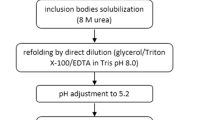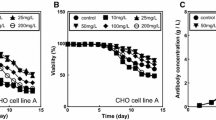Abstract
We recently developed a new dialysis culture system (termed LIFROC-device) for the cultivation of lymphokine-activated killer cells (Murataet al., 1990, 1991). In the present study, we applied the LIFROC-device (400 ml culture vessel) to the cultivation of mammalian cells for the production of biologically active substances. We cultured mouse-mouse hybridoma TP-709, secreting anti-tissue plasminogen activator (tPA) monoclonal antibody (mAb), recombinant CHO GT19, secreting hGH, and human melanoma Bowes cells, secreting tPA. With the LIFROC-device, TP-709 grew to a maximal cell density of 3.8×106 cells/ml and and produced 480 μg/ml (192 mg in total) of mAb. GT19 reached a cell density of 2.2×106 cells/ml and produced 302 μg/ml (120 mg in total) of hGH. Bowes cells expanded to 4.4×106 cells/ml and secreted 8.5 μg/ml (3.3 mg in total) of tPA. The protein concentration in the culture broths of the LIFROC-device became 7–200 times higher than that of batch culture. Thus, the LIFROC-device can be applied to protein production as well as cell growth with high efficiency.
Similar content being viewed by others
Abbreviations
- LAK:
-
lymphokine-activated killer
- MW:
-
molecular weight
References
Adamson SR, Fitzpatrick SL, Behie LA, Gaucher GM and Lesser BH (1983)In vitro production of high titre monoclonal antibody by hybridoma cells in dialysis culture. Biotechnol Lett 5: 573–578.
Hata J, Tamura T, Yokoshima S, Yamashita S, Kabeno S, Matsumoto K & Onodera K (1992) Chemically defined medium for the production of biologically active substances of CHO cells. Cytotechnology 10: 9–14.
Knazek RA, Gullino PM, Kohler PO and Robert LD (1972) Cell culture on artificial capillaries: An approach to tissue growthin vitro. Science 178: 65–66.
Kohgo Y, Sakamaki S, Kainisawa Y, Nojiri S, Ueno Y, Itoh Y, Takahashi M, Sasagawa Y, Hosoi S, Sato S and Niitsu Y (1989) Generation of lymphokine activated killer cells in a new high cell density dialyzing culture apparatus. Cytotechnology 2: 49–57.
Marbrook J and Auckland MS (1967) Primary immune response in cultures of spleen cells. Lancet 2: 1270–1281.
Markl H, Kurosawa H, Matsumura M and Tanaka H (1989) New dialysis bioreactor for animal cell culture. In: H Murakami (ed) Trends in Animal Cell Culture Technology: 139–144.
Miyamoto M, Murata M, Yoshino I, Togami M, Yano T, Yasumoto K, Sugimachi K, Kimura G and Nomoto K (1992) Development of a new disposable culture system for human lymphokine activated killer (LAK) cells. JAACT'92 Program, p 98 (abstract).
Murata M, Yano T, Togami M, Yasumoto K, Sugimachi K, Kimura G & Nomoto K (1990) Development of a new culture system for human lymphokine-activated killer cells. J Immunol Methods 129: 89–95.
Murata M, Yano T, Yoshino I, Togani M, Sogabe M, Yasumoto K, Sugimachi K, Kimura G & Nomoto K (1991) Development of a new culture systems for human lymphokine-activated killer cells: Comparison with a conventional static culture method. Cytotechnology 7: 75–83.
Noto T, Tokuda Y, Nakamura Y, Suzuki A, Watanabe K, Yamamura M, Tajima T, Mitomi T and Nishijima K (1989) A new high-yield continuous cell-culture system for lymphokine-activated killer cells. Cancer Immunol Immunother 30: 1–4.
Omasa T, Higashiyama K, Shioya S and Suga K (1989) Effect of lactate concentration on hybridoma cell culture in the fedbatch operation. In: H Murakami (ed) Trends in Animal Cell Culture Technology, pp. 105–108.
Ozturk SS, Riley MR and Palsson BO (1991) Effect of ammonia and lactate on hybridoma growth, metabolism, and antibody production. Biotech Bioeng 39: 418–431.
Author information
Authors and Affiliations
Rights and permissions
About this article
Cite this article
Murata, M., Togami, M., Tawara, Y. et al. A new culture system for the cultivation of mammalian cells for the production of several biologically active substances. Cytotechnology 13, 143–148 (1993). https://doi.org/10.1007/BF00749941
Received:
Accepted:
Issue Date:
DOI: https://doi.org/10.1007/BF00749941




